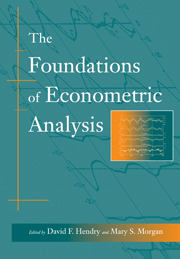Book contents
- Frontmatter
- Contents
- Preface
- Acknowledgements
- Introduction
- Bibliography
- I The Emerging Role of Econometrics in Economics
- II Early Time-Series Analysis
- III Applied Econometrics and the Identification Problem
- IV The Evolution of Statistical Thinking in Econometrics
- 21 Statistical Laws of Demand and Supply with Special Application to Sugar (University of Chicago Press, Chicago, 1928, pp. 27–39)
- 22 ‘Pitfalls’ Debate (Quarterly Journal of Economics, vol. 48, 1934, pp. 355–61, 749–51, 755–66)
- 23 Statistical Confluence Analysis by Means of Complete Regression Systems (University Institute of Economics, Oslo, 1934, pp. 5–8)
- 24 Linear Regression Analysis of Economic Time Series (Netherlands Economic Institute, Haarlem, 1937, pp. 1–10, 54–63, 129–32)
- 25 Statistical Testing of Business Cycle Theories: A Method and Its Application to Investment Activity (League of Nations, Geneva, 1939, vol. I, pp. 27–33)
- 26 Residual Variables in Regression and Confluence Analysis (Skandinavisk Aktuarietidskrift, vol. 28, 1945, pp. 201–10)
- V Dynamic Models
- VI The Tinbergen Debate
- VII Structure and Simultaneity
- VIII The Probabilistic Revolution
- IX Exogeneity
- Index
23 - Statistical Confluence Analysis by Means of Complete Regression Systems (University Institute of Economics, Oslo, 1934, pp. 5–8)
Published online by Cambridge University Press: 05 June 2012
- Frontmatter
- Contents
- Preface
- Acknowledgements
- Introduction
- Bibliography
- I The Emerging Role of Econometrics in Economics
- II Early Time-Series Analysis
- III Applied Econometrics and the Identification Problem
- IV The Evolution of Statistical Thinking in Econometrics
- 21 Statistical Laws of Demand and Supply with Special Application to Sugar (University of Chicago Press, Chicago, 1928, pp. 27–39)
- 22 ‘Pitfalls’ Debate (Quarterly Journal of Economics, vol. 48, 1934, pp. 355–61, 749–51, 755–66)
- 23 Statistical Confluence Analysis by Means of Complete Regression Systems (University Institute of Economics, Oslo, 1934, pp. 5–8)
- 24 Linear Regression Analysis of Economic Time Series (Netherlands Economic Institute, Haarlem, 1937, pp. 1–10, 54–63, 129–32)
- 25 Statistical Testing of Business Cycle Theories: A Method and Its Application to Investment Activity (League of Nations, Geneva, 1939, vol. I, pp. 27–33)
- 26 Residual Variables in Regression and Confluence Analysis (Skandinavisk Aktuarietidskrift, vol. 28, 1945, pp. 201–10)
- V Dynamic Models
- VI The Tinbergen Debate
- VII Structure and Simultaneity
- VIII The Probabilistic Revolution
- IX Exogeneity
- Index
Summary
Introduction
The Object of Confluence Analysis, the Danger of Including too Many Variates in a Regression Analysis
In a paper ‘Correlation and Scatter …’ in Nordic Statistical Journal 1928 I drew attention to the fact that in statistical regression analysis there exists a great danger of obtaining nonsensical results whenever one includes in one and the same regression equation a set of variates that contain two, or more, subsets which are already – taken by themselves – highly intercorrelated. Suppose, for instance, that we have three statistical variates x1, x2, x3 (measured from their means), and that we know for a priori reasons that there exist not only one but two independent linear equations between them (since the variates are measured from their means, we may assume the equations to be homogeneous). Further, suppose that a great number of observations are made, each observation giving the values of the three variates and being represented as a point in the three dimensional (x1, x2, x3) space. All these observation points would then lie on a straight line through origin in (x1, x2, x3) space. From the distribution of these points it would be absurd to try to determine the coefficients of any of the two equations that we know a priori should exist between the variates. Indeed, a set of points lying in a line does not contain enough information to determine a plane.
- Type
- Chapter
- Information
- The Foundations of Econometric Analysis , pp. 271 - 273Publisher: Cambridge University PressPrint publication year: 1995
- 2
- Cited by

